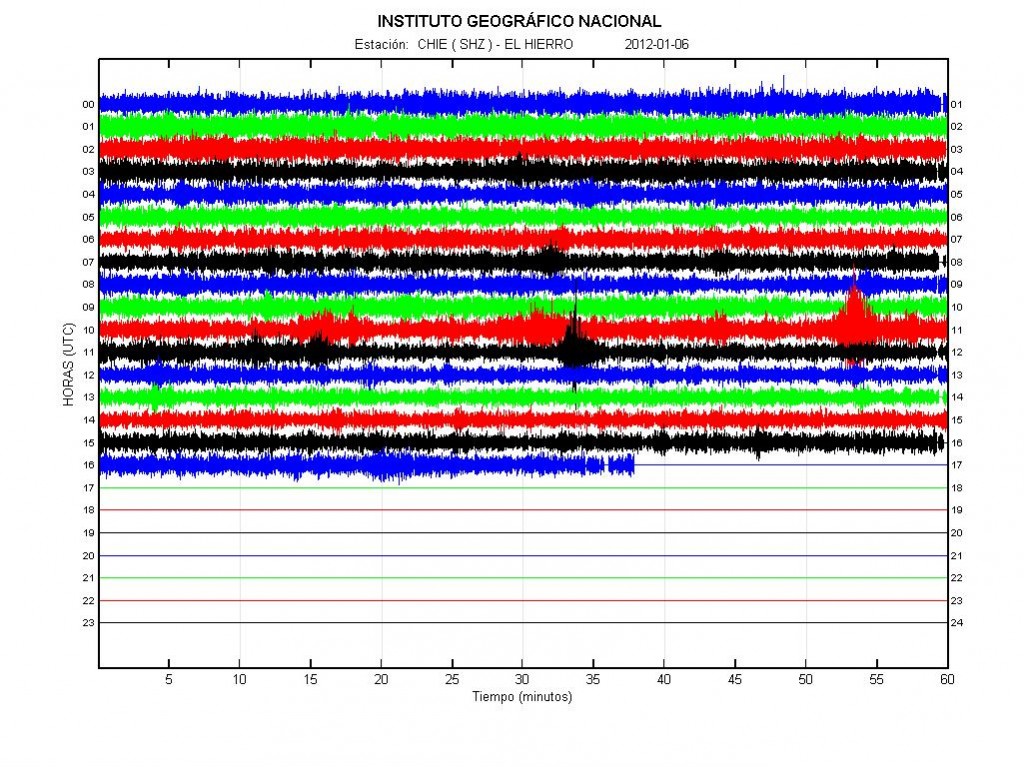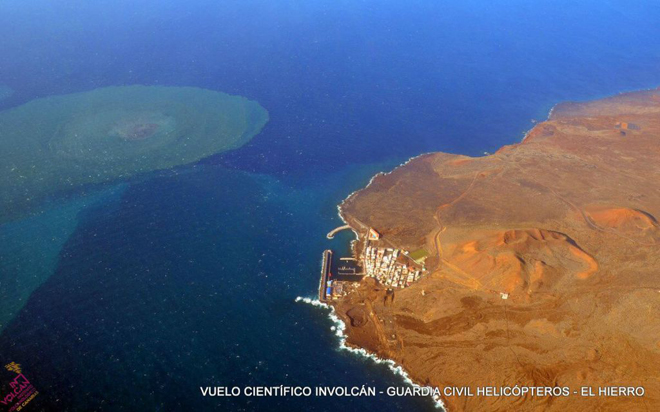Since yesterday there has been an renewed eruption activity in El Hierro volcano. Harmonic tremor has not seen big increase however. This suggest that this new eruption so far is small and mot procuring a lot of lava to the surface. Some floating pyroclastic has been spotted on web cameras and by local people when they come up to the surface. This eruption activity appears be intermittent at the moment. Going on and off every few hours to days.

The harmonic tremor from the eruption in El Hierro volcano. Harmonic tremor remains low however, so there is not a lot of energy in this eruption at the moment. Spikes in the tremor chart are most likely explosions taking place in the eruption area. Copyright of this picture belongs to IGN (Instituto Geográfico Nacional).
The eruption appears to have started again following an new dike intrusion from great depth into El Hierro volcano. This was followed by few earthquakes. All of them where small. If more new magma flows into El Hierro volcano this new eruption episode is going to increase in strength and in power. But it is hard to be sure if that is going to happen or not.

Eruption area in El Hierro volcano. This new eruption seems to be closer to the coast line then before. Copyright of this picture belongs to INVOLCAN. Picture is via Eruption blog (Erik Klemetti)
It is impossible to know what happens next in El Hierro volcano. So watching is important thing to do.
Other blogs about this new eruption.
Renewed Activity at El Hierro in the Canary Islands (Wired Science)

The volcano seems to have emitted some large pyroclasts today; some of which floated for some time and seemed to have been hot enough to create steam. Also some large gas grey-ish bubbles.
May be the volcano is closer to the surface or the vent is wider, allowing large bubbles (but it has produced larger bubbles before).
Not too sure but the current activity may be in line with the NNW-SSE line through Taracon.
OT there have been a couple of quakes in Askja.
There was persistent strong surface activity & steaming while I was watching for a couple of hours last night (Eastern Australian time). It is worth remembering that a reduction in harmonic tremor doesn’t necessarily mean the eruption is slowing down, rather it can indicate that the vent is unblocked and flowing smoothly.
It is impossible to know what happens next in El Hierro volcano. So watching is important thing to do.
This a quote from Jon.
I agree but it is difficult when the web cams and seismometer malfunction!
Ustream is working now.
The jacuzzi is emitting some large steaming pyroclasts. There also appears to be a second stain with an active area of bubling.
Whats up with that supervolcano in Germany? Is there possible to see any data from there?
It’s NOT a supervolcano. It’s only about the average size. The “super” was a lie invented by the yellow page media…
I found this page from the University of Cologne with data of current earthquake activity near the Rhine. Eifel is near Bonn and Koblenz west of the Rhine.
http://www.seismo.uni-koeln.de/emap/index.htm
To be fair though Jack, if Laacher See was to go off with its usual bang & given its proximity to northern European capitals and population centres, the effects would be ‘super’. As in big, not good! 🙂
The definition of a supervolcano calls for 1000 km3 of eruption products.
The Laacher See eruption about 12900 BP is estimated to have erupted something like 16 km3 of tephra, i.e. it was 60 times too weak to account for the misnomer given by those British rubbish papers.
And, I was not talking about the possible effects. Any volcano eruption has effects. It depends on the amount, spread and quality of the products, whethet the effects are minimal or significant.
The last eruption of the Eifel Volcanic Field happened approximately 10000 year ago, since that time its dormant, and there is no real sign that its status is changing in anyway currently. There is some bubbling carbon dioxide in th Laacher See, but that was always there and didn’t change in activity. But during the last 800000 years there always were eruptions with sleeping intervalls of some 1000 or 10000 years. So be patient, wait some 1000 or 10000 years more and there will eventually be another, maybe big, volcanic event. But most probably not today, not tomorrow, not in the next 100 or 1000 years. But, on the other hand, you never know …
Eh, I forgot, its 2012, so it will be erupting this year!
Let’s talk about it again after next Xmas! 😉
Nice work there Amandus! I wonder though if the Eifel field is connected to the movement of the African plate northwards under the eurasion plate or if it is purely a result of a hot spot / plume?
There seems to be a belt of extinct (mostly) or dormant volcanoes some hundred kilometers north of the Alps from Chaine des Puys in France to Eifel and Vogelsberg Mountains and others in Germany and Volcanoes near Cheb in Czech. I think i have read a theory that this is something like a shockwave from the folding up of the Alps. But then i read that there are hot spots under Chaine des Puys, Eifel and Cheb. I don’t know how that fits together.
The volcanic effects of the collision of the present African continent to the former Eurasian continent can be seen in Italy and Greece, not any farther in the North. Laacher See is probably due to hot spot volcanism.
The Alps were born slightly earlier, due to an collision of the Northern edge of the former African plate (incl. present Italy and Greece) to the former Eurasian plate. Carpathians are part of the same group of the so called Alpide Mountain Chain, or Alpide Belt.
New blog post is up! It is about the earthquake activity in Upptyppingar tuff mountains.